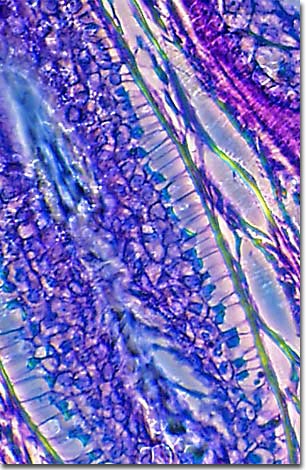Phase Contrast Image Gallery
Human Tattoos
Tattoos are experiencing a dramatic surge in popularity, with more women acquiring this body art than ever before. The phase contrast image illustrated below was made from a stained thin section of human tissue emblazoned with a tattoo.

Tattoos are created by injecting colored pigments, or inks, into the dermal layer of the skin. Unlike the epidermis, which is continually sloughing, the dermis stays intact throughout a lifetime, and so does the tattoo once it's been injected.
This creative form of body art is an ancient human practice, found in various cultures throughout history and even prehistory. In 1991, the oldest mummified human body ever found intact was discovered in the Alps on the Italian-Austrian border. The body was dated to around 3,300 BC, but the skin was so well preserved that researchers could observe short blue lines on the skin (lower spine, left leg, and right ankle), which some scientists believe to be the first tangible evidence of Neolithic era tattoo work.
There are an amazing variety of tattooing methods amongst different cultures. Most have used some method of pricking or scratching the skin, followed by rubbing pigments into the open wounds. One traditional method practiced by some Inuit tribes of the Arctic and Subarctic, was to make a needle puncture through which a thread saturated with pigment (usually soot) was drawn through the skin layer. In Polynesia and Micronesia, pigment was injected into the skin by tapping the skin with a tool shaped like a small rake.
The modern method of creating tattoos uses a machine that works something like a sewing machine. Solid needles move up and down, puncturing the skin at the rate of 50 to 3,000 times a minute, injecting insoluble micrometer-sized particles of inks about one-eighth inch deep into the skin dermis.
BACK TO THE PHASE CONTRAST GALLERY
